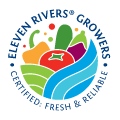Environment Protection
Axis 5. Social Responsibility System
Headland 10. Environment Protection
5.10.1. Legal Use of Water
The company must document the necessary evidence to prove compliance of the legal use of water in relation to current regulations on the subject; the company must document the corresponding permits issued by government organizations regulating the vital liquid.
If the Participating Grower uses as a source the extraction of well water, the documentation must contain the legal documents issued by the corresponding government institution.
5.10.2.Rational Water Use
A program for the rational use of water used in agriculture irrigation and in all areas of the company must be documented, with priority in the use of efficient technologies.
It should be documented, with evidence, the results of the implementation of the program for the rational use of water, using economic, environmental or trade indicators, which reflect the impact of the actions taken.
5.10.3. Wastewater Management
If the company discharges its wastewater into national assets (drains, rivers, sea, etc.) or the municipal sewage system, must document and implement measures for the treatment of these wastewaters.
These measures should be substantiated demonstrating compliance with the applicable standard (NOM-001-ECOL-1996 for download in national assets, or NOM-002-ECOL-1996 for municipal sewage discharge).
In cases where the company decides to unload their waste treatment in plants that do not belong to this (for example, in treatment plants of the Municipal Board), it must show documentation supporting this action.
When the producer chooses to hire a company to handle wastewater, for example toilets or drainage ditches, it must be shown that it gives you a safe final destination for the waste.
5.10.4. Rational use of electricity
A program for the rational use of electrical energy should develop, including actions such as the purchase of inputs and energy savers compounds, machinery and environmentally friendly equipment.
Evidence should be documented with the results of the implementation of the program for the rational use of electricity, using economic, environmental or trade indicators, which reflect the impact of the actions taken.
5.10.5. Proper Waste Management and Recycling
The company must develop and document a procedure to give a safe final destination to garbage and other wastes caused from the production operation and to recycle some wastes, such as plastic, paper, metal, etc. This procedure must differentiate the hazardous waste, packaging, quilting, ribbon, raffia and biological-infectious hazardous waste, etc. and give them a destination that complies with applicable regulations.
Waste includes waste materials, unused packages and byproducts created in the fields, greenhouses, packaging and housing facilities, recreation centers, childcare facilities, schools and any other area of the company generating sub-products that may not be used in the production process.
Companies also have the option of outsource a specialized company for the safe o recycling final destination of these wastes; this company must comply with the regulations in the subject and must deliver the Participating Grower a proof guaranteeing the safe final destination of wastes.
5.10.6.Legal Origin of Wooden Stakes
The most common practice is to use wood in crop tutoring. In accordance with current Natural
Regulations, the forest raw material must comply with a Forest Guide and its correspondent Commercial invoice. The company must verify the authenticity of the documents delivered by the supplier and that these documents are free from erasures and deletions.
5.10.7. Reforestation
To mitigate the impact of economic activity in the region, the company must reforestation activities on roads and shelters, as well as promoting the planting of forest species that help conserve specific biodiversity. It must retain evidence of the acquisition of plants and develop a sketch where the reforested areas are indicated.



